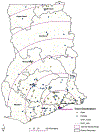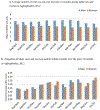Is It the Timing? Short-Term Mobility and Coital Frequency in Agbogbloshie, Ghana
- PMID: 32989638
- PMCID: PMC7889649
- DOI: 10.1007/s10508-020-01815-7
Is It the Timing? Short-Term Mobility and Coital Frequency in Agbogbloshie, Ghana
Abstract
Short-term mobility is often associated with increased sexual risk behavior. Mobile individuals often have higher rates of sexual risk behavior compared to non-mobile individuals, but the reasons why are not clear. Using monthly retrospective panel data from 202 men and 282 women in Agbogbloshie, Ghana, we tested whether short-term mobility was associated with changes in coital frequency, and whether the association was due to the act of travel in the given month (e.g., enabling higher risk behavior), the reason for travel, or an individual's travel propensity at other times in the year. Overnight travel specifically to visit family or friends, or for education, health, or other reasons, was associated with increased coital frequency for men. However, men with higher travel propensities had lower overall coital frequency and the act of traveling enabled more sex only for the most frequent male travelers. Men who seldom traveled had much higher coital frequency, but the act of traveling was not associated with additional sex acts. For women, travel for education, health, or other reasons increased coital frequency. Occasional female travelers had slightly more sex acts compared to non-mobile women, and the act of traveling for these women was associated with slight increases in coital frequency, supporting the enabling hypothesis. Highly mobile women had fewer sex acts per month on average. Our findings suggest that mobility characteristics measured on a broad temporal scale, as well as the reason for mobility, are important to understand the relationship between short-term mobility and sexual behavior.
Keywords: Circular migration; Ghana; Health; Sexual risk behavior; Temporal scale.
Conflict of interest statement
Figures



Similar articles
-
Geographic mobility and potential bridging for sexually transmitted infections in Agbogbloshie, Ghana.Soc Sci Med. 2017 Jul;184:27-39. doi: 10.1016/j.socscimed.2017.05.003. Epub 2017 May 5. Soc Sci Med. 2017. PMID: 28501018 Free PMC article.
-
Coital Frequency and Male Concurrent Partnerships During Pregnancy and Postpartum in Agbogbloshie, Ghana.AIDS Behav. 2019 Jun;23(6):1508-1517. doi: 10.1007/s10461-019-02403-0. AIDS Behav. 2019. PMID: 30673896 Free PMC article.
-
Sexual Pleasure and Function, Coital Trauma, and Sex Behaviors After Voluntary Medical Male Circumcision Among Men in the Dominican Republic.J Sex Med. 2017 Apr;14(4):526-534. doi: 10.1016/j.jsxm.2017.01.020. Epub 2017 Mar 1. J Sex Med. 2017. PMID: 28258953
-
Migration, sexual networks, and HIV in Agbogbloshie, Ghana.Demogr Res. 2014 Oct 10;31:861-888. doi: 10.4054/DemRes.2014.31.28. Demogr Res. 2014. PMID: 25364298 Free PMC article.
-
Prostatic cancer, coital rates, vasectomy and testosterone.J Biosoc Sci. 1994 Apr;26(2):269-72. doi: 10.1017/s0021932000021295. J Biosoc Sci. 1994. PMID: 8014182 Review.
Cited by
-
Factors Associated with Short and Long Term Mobility and HIV Risk of Women Living in Fishing Communities Around Lake Victoria in Kenya, Tanzania, and Uganda: A Cross Sectional Survey.AIDS Behav. 2023 Mar;27(3):880-890. doi: 10.1007/s10461-022-03824-0. Epub 2022 Sep 10. AIDS Behav. 2023. PMID: 36088399 Free PMC article.
-
Predictors of migration in an HIV hyper-endemic rural South African community: evidence from a population-based cohort (2005-2017).BMC Public Health. 2022 Jun 7;22(1):1141. doi: 10.1186/s12889-022-13526-w. BMC Public Health. 2022. PMID: 35672845 Free PMC article.
References
-
- Awumbila M, & Ardayfio-Schandorf E (2008). Gendered poverty, migration and livelihood strategies of female porters in Accra, Ghana. Norwegian Journal of Geography, 62(3), 171–179. 10.1080/00291950802335772. - DOI
-
- Brockerhoff M, & Biddlecom AE (1999). Migration, sexual behavior and the risk of HIV in Kenya. International Migration Review, 33(4), 833–856. 10.2307/2547354. - DOI

